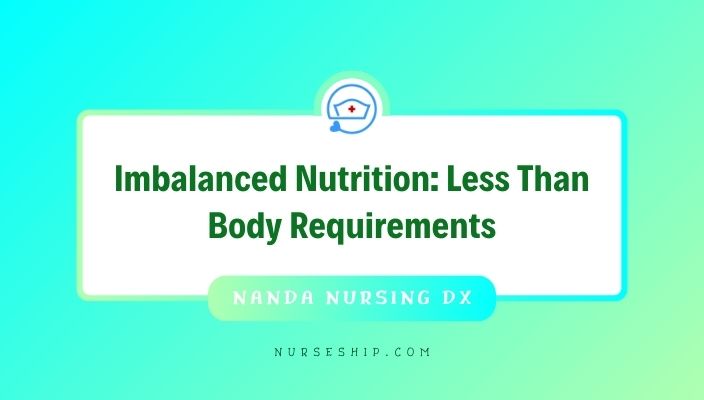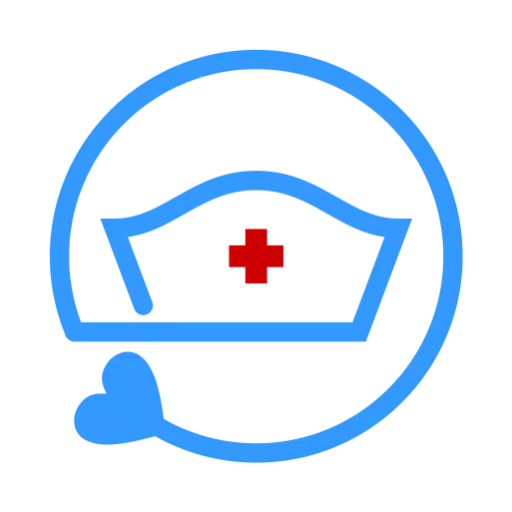Last updated on December 28th, 2023
In this article, we will explore the NANDA nursing diagnosis “Imbalanced Nutrition: Less than Body Requirements.” This diagnosis addresses a situation where an individual’s intake of essential nutrients does not meet their body’s metabolic needs.
Imbalanced Nutrition: Less Than Body Requirements
History
The nursing diagnosis “Imbalanced nutrition: less than body requirements” was originally approved in 1975, and it has undergone revisions in the years 2000, 2017, and 2020.
These revisions have been informed by an evolving body of evidence and clinical knowledge. The current status of this nursing diagnosis is supported by a Level of Evidence rating of 2.1.
NANDA Definition of Imbalanced nutrition: less than body requirements
NANDA defines imbalanced nutrition: less than body requirements as “intake of nutrients insufficient to meet metabolic needs.”
Defining Characteristics of “Imbalanced Nutrition: Less than Body Requirements”
Defining characteristics of “Imbalanced Nutrition: Less than Body Requirements” include:
- Abdominal cramping
- Abdominal pain
- Body weight below the ideal range for age and gender
- Lack of satiety
- Poor muscle tone
- Fatigue
- Hair loss
- Dry scaly skin
- Constipation
- Delayed wound healing
- Diarrhea
- Excessive hair loss
- Food intake below recommended daily allowance (RDA)
- Hyperactive bowel sounds
- Hypoglycemia
- Inadequate head circumference growth for age and gender
- Inadequate height increases for age and gender
- Lethargy
- Neonatal weight gain of less than 30 g per day
- Pale mucous membranes
- Weight loss despite adequate food intake
Risk Factors Related to the Nursing Diagnosis of “Imbalanced Nutrition: Less than Body Requirements”
Risk Factors that are related to the nursing diagnosis of “Imbalanced Nutrition: Less than Body Requirements” include:
- Changes in taste perception
- Presence of depressive symptoms
- Difficulty with swallowing
- Aversion to food
- Presence of inaccurate information
- Inadequate availability of food
- Lack of interest in food
- Insufficient knowledge about nutrient requirements
- Injury to the buccal cavity
- Inadequate production of breast milk
- Disruption in breastfeeding
- Misinterpretation of one’s ability to ingest food
- Feeling of fullness immediately after eating
- Discomfort or soreness in the buccal cavity
- Weakened muscles necessary for swallowing
- Weakening of muscles necessary for mastication
Risk Population
Population groups that are at an increased risk for the nursing diagnosis “Imbalanced Nutrition: Less than Body Requirements” include:
- Competitive athletes
- Individuals who have been displaced from their homes
- People who are economically disadvantaged
- Individuals with limited access to education
- Premature infants
Related Medical Conditions
Medical conditions that predispose individuals to imbalance nutrition less than body requirement include:
- Body dysmorphic disorders
- Diseases affecting the digestive system
- Immunosuppression
- Kwashiorkor
- Syndromes causing malabsorption
- Mental health disorders
- Neoplasms (tumor growths)
- Neurocognitive disorders
- Parasitic infections
- Metabolic disorders
Nursing Interventions for Imbalanced Nutrition: Less Than Body Requirements
| Nursing Interventions | Rationale |
| Perform a nutritional assessment | A comprehensive assessment helps identify the individual’s nutritional status, dietary habits, and contributing factors. |
| Collaborate with a registered Dietitian | Dietitians are experts in nutrition and can provide tailored dietary plans that meet the individual’s specific needs and preferences. |
| Educate the patient about balanced nutrition | Providing knowledge about the importance of adequate nutrient intake helps the patient understand the significance of dietary changes and motivates them to make healthier food choices. |
| Assist with meal planning | Guiding the patient in planning balanced meals ensures they receive the necessary nutrients and energy to meet their body’s requirements. |
| Monitor and record food intake | Keeping track of the patient’s food consumption helps identify patterns of inadequate intake and allows for adjustments to the dietary plan. |
| Encourage small, frequent meals | Eating smaller, more frequent meals can help increase nutrient intake and prevent overwhelming the patient with large portions. |
| Offer nutritional supplements | Supplements provide additional nutrients when dietary intake is insufficient, aiding in meeting the body’s requirements. |
| Address psychosocial factors | Addressing depression, anxiety, and other emotional factors that may affect appetite and eating habits can positively impact the patient’s willingness to eat. |
| Provide oral care and assess for dysphagia | Maintaining good oral health and addressing swallowing difficulties ensure that the patient can eat comfortably and safely. |
| Collaborate with a speech therapist | Speech therapists can assess and address any speech or swallowing difficulties that may hinder adequate food intake. |
| Monitor weight and anthropometric measurements | Regular assessments help track changes in the patient’s nutritional status and provide a clear picture of progress over time. |
| Evaluate laboratory results | Monitoring laboratory values, such as albumin and prealbumin levels, can help gauge the patient’s nutritional status and response to interventions. |
| Involve family or caregivers | Educating and involving family members or caregivers can ensure that the patient receives support and encouragement to follow dietary recommendations. |
| Monitor and address side effects of supplements | Nutritional supplements can sometimes cause gastrointestinal discomfort or other side effects. Monitoring and addressing these issues enhance compliance. |
See Also
- 19 NANDA Nursing Diagnosis for Fracture |Nursing Priorities & Management
- 9 NANDA nursing diagnosis for Cellulitis |Management |Patho |Pt education
- 20 NANDA nursing diagnosis for Chronic Kidney Disease (CKD)
Conclusion
“Imbalanced Nutrition: Less than Body Requirements” is a nursing diagnosis that highlights the critical importance of proper nutrition for overall health.
By recognizing the signs, understanding contributing factors, and implementing targeted interventions, nurses and healthcare professionals can play a pivotal role in helping individuals achieve balanced nutrition and improved well-being.
Recommended Readings
NANDA International Nursing Diagnoses: Definitions and Classification 2021-2023 (12th Edition)


